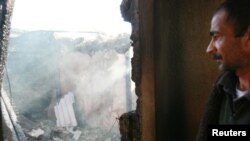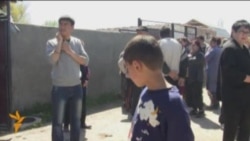RFE/RL has reported that some of yesterday’s violence in Kyrgyzstan, which claimed the lives of at least three people, was ethnically motivated. Amid speculation that Russians were being targeted, Russian President Dmitry Medvedev swung into action, ordering his defense minister to ensure the security of Russian citizens in the country.
But in the village of Maevka, RFE/RL correspondents reported that the main target of attacks appeared to have been Meskhetian Turks.
Who?
Not exactly major players on the geopolitical landscape, that’s for sure.
The ethnic origin of Meskhetian Turks is still a subject of debate among scholars. While some argue that they are ethnic Turks, others believe they were forcibly converted to Islam by Ottoman forces who invaded their homeland, Meskheti, in southwestern Georgia. With a culture and dialect formed from both Turkish and non-Turkish elements, the Meskhetian Turks number between 300,000 and 400,000 people.
In recent history, they have been persecuted and displaced, starting in 1944, when Stalin deported more than 100,000 of them from Meskheti for alleged disloyalty to the Soviet Union. They were cast across Central Asia and thousands died in the process.
In 1989, some 100 Meskhetian Turks were killed in ethnically motivated violence in present-day Uzbekistan’s Ferghana Valley, prompting Soviet authorities to evacuate them. A large number were moved to the Krasnodar area.
After the fall of the Soviet Union, they existed in stateless legal limbo, and in Krasnodar, faced state-sanctioned persecution. In recent years, as plans for Georgian repatriation have stalled, there has been a mass immigration of Meskhetian Turks to the United States.
WATCH: Meskhetian Turks in the Kyrgyz village of Maevka become a target of attacks as rioters loot and burn their houses:
For the thousands who remain in Central Asia, ethnically motivated violence persists. A EurasiaNet.org report recounted one man’s experience of the April 19 events in Kyrgyzstan:
But whatever the cause, it is nothing new for the long-persecuted group.
Nevertheless, there are some who are looking out for the estimated 20,000-30,000 Meskhetian Turks living in Kyrgyzstan. Today, Turkish Ambassador Nejat Akcal visited the village of Maevka and urged authorities to prevent further attacks.
And again from EurasiaNet.org:
-- Richard Solash
But in the village of Maevka, RFE/RL correspondents reported that the main target of attacks appeared to have been Meskhetian Turks.
Who?
Not exactly major players on the geopolitical landscape, that’s for sure.
The ethnic origin of Meskhetian Turks is still a subject of debate among scholars. While some argue that they are ethnic Turks, others believe they were forcibly converted to Islam by Ottoman forces who invaded their homeland, Meskheti, in southwestern Georgia. With a culture and dialect formed from both Turkish and non-Turkish elements, the Meskhetian Turks number between 300,000 and 400,000 people.
In recent history, they have been persecuted and displaced, starting in 1944, when Stalin deported more than 100,000 of them from Meskheti for alleged disloyalty to the Soviet Union. They were cast across Central Asia and thousands died in the process.
In 1989, some 100 Meskhetian Turks were killed in ethnically motivated violence in present-day Uzbekistan’s Ferghana Valley, prompting Soviet authorities to evacuate them. A large number were moved to the Krasnodar area.
After the fall of the Soviet Union, they existed in stateless legal limbo, and in Krasnodar, faced state-sanctioned persecution. In recent years, as plans for Georgian repatriation have stalled, there has been a mass immigration of Meskhetian Turks to the United States.
WATCH: Meskhetian Turks in the Kyrgyz village of Maevka become a target of attacks as rioters loot and burn their houses:
For the thousands who remain in Central Asia, ethnically motivated violence persists. A EurasiaNet.org report recounted one man’s experience of the April 19 events in Kyrgyzstan:
Binali Dursunov, 50, says he believes he was targeted for his ethnicity. "They were running around yelling, ’Go away Turks, this is our land,’" he told EurasiaNet.org, standing in the gutted, burned shell of his family home. "They went to the Turkish houses and some Russian houses got damaged on the other side of the village as well.
EurasiaNet.org reports that squatters perpetrated the attacks, as they looked to grab land in the wake of ex-President Kurmanbek Bakiev’s ouster.But whatever the cause, it is nothing new for the long-persecuted group.
Nevertheless, there are some who are looking out for the estimated 20,000-30,000 Meskhetian Turks living in Kyrgyzstan. Today, Turkish Ambassador Nejat Akcal visited the village of Maevka and urged authorities to prevent further attacks.
And again from EurasiaNet.org:
Praising her ethnic Kyrgyz neighbors, Dursunov’s Meskhetian neighbor Sonya Omurkanova, 40, said, "Our Kyrgyz neighbors were coming out, standing in the gates to the Turkish houses, telling the crowd it is a Kyrgyz home; the crowds then passed by." The Kyrgyz also hid some Turks.
-- Richard Solash








